Galago Profile
Galagos, also known as bush babies, are small arboreal primates found in Sub-Saharan Africa. They have large eyes, bat-like ears and remarkable jumping ability.
There are currently 23 species of bush babies in the Galagidae family, and some experts believe there are more to be discovered and classified.
They are nocturnal creatures and consequently have large forward facing saucer-eyes to allow as much light into them as possible when foraging in trees at night.
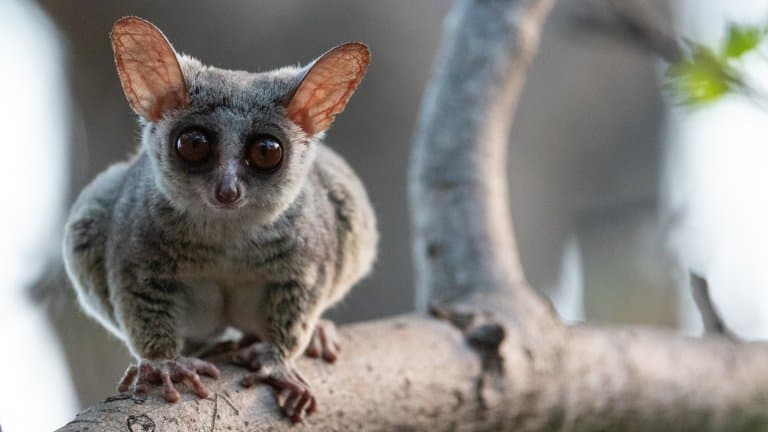
Galago Facts Overview
| Habitat: | Forests and woodlands |
| Location: | Sub-Saharan Africa |
| Lifespan: | Up to 16 years in some species |
| Size: | 12 – 37 cm (not including the tail) |
| Weight: | 60 g – 2 kg |
| Color: | Varies by species but fur is generally grey, brown, reddish or yellowish brown |
| Diet: | Fruit, insects, gum from certain trees, some species eat small amphibians and birds |
| Predators: | Mongoose, genets, jackals, domestic dogs and cats, owls, snakes, sometimes other primates, leopard and hyena |
| Top Speed: | Unknown |
| No. of Species: |
23+ |
| Conservation Status: |
Least concern |
Galagos are found all through Africa and live in a variety of different forest types.
These can range from more tropical rainforests to acacia woodland in savannah areas. Even in desert type regions, bush babies can be found in thorny foliage. Different species of bush baby have adapted to survive in so many different habitats across the continent.
Bush babies come in a variety of sizes, however the one thing that they all have in common is that they can jump great distances from one tree to another, clinging to branches. Some of the most agile bush babies are the ones known as the ‘lesser bush babies’. They are one of the smallest primates known and being slight, they can nip through the trees with ease, even thorny bushes.
Most species spend the majority of their times in trees, even utilising water collected in leaves and the like rather than visit the ground to drink. Bush babies use their long hind limbs to jump from tree to tree through the forest canopy in search of food. They are omnivores, and will eat insects, as well as fruit and gum from certain tree species.
Their well-developed eyes help them judge distances accurately. As well as great night vision, they also have large ears that can move independently, which is especially helpful when tracking insects to prey upon, or when keeping vigilant for predators.
Although the gestation period in different species of bush baby can vary, it is usually between 3-4 months. After this time they generally give birth to 1-2 young in leaf nests or tree hollows. The young are fairly well developed and have their eyes open.
Mother and offspring will leave the nest after a few days, where the mother will carry the young in her mouth to help move them around and will leave them on a branch while she forages. In some species of bush baby the young will cling to the mothers back during nightly movements!
Interesting Galago Facts
1. They are also known as ‘nagapies’
Galagos are sometimes called bush babies, as well as ‘nagapies’, which means ‘night monkeys’ in Afrikaans, in reference to their nocturnal behaviour.
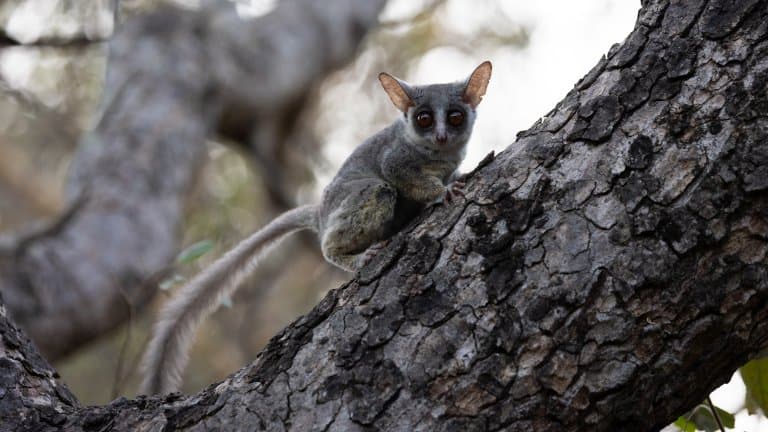
2. They can fold and rotate their ears
As they are bounding through trees and bushes, galagos will put their ears flat to their heads to help protect them from getting caught on branches, thorns and the like.
They also put their ears down when sleeping to help keep their surroundings a little quieter. Their ears can also rotate independently like radar dishes to help zero in on sounds from prey. 1
3. Listening to their vocalisations has helped identify more species
Some galago species look very similar! Scientists studying the vocal communication between bush babies have helped separate different species, originally thought to be the same one.
By listening to their distinct calls they have understood that how a bush baby looks is not enough to help identify it. Listening to their different calls is the key to identifying different species. 2
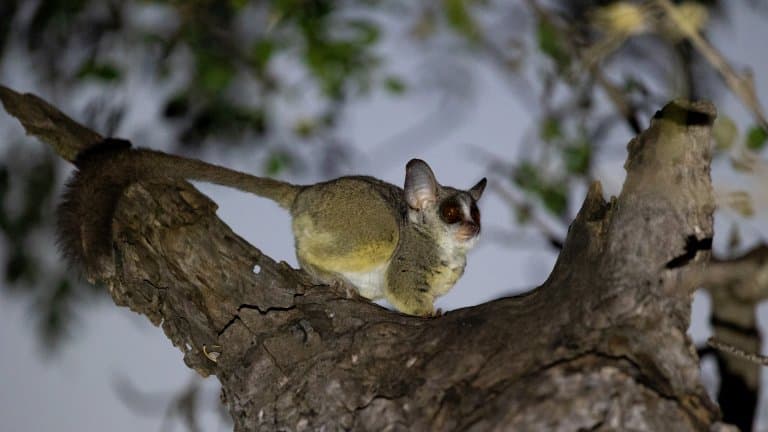
4. They mark their paths with urine
As they walk, run and jump through the trees, bush babies will mark the routes that they take with urine, sometimes by urinating on their hands and feet to help spread the scent.
This serves as a reminder of their routes, especially to nesting spots.
Males will also mark their territory boundaries with urine and sometimes members of social groups will be marked with urine too!
5. Some of their teeth are modified
Some of the bush babies lower teeth are adapted into what is called a grooming or scraper comb, which they use to remove hairs and debris from their own and others thick coats.
They also use these tooth combs to scrape at bark to help extract gum which is one of their main food sources.
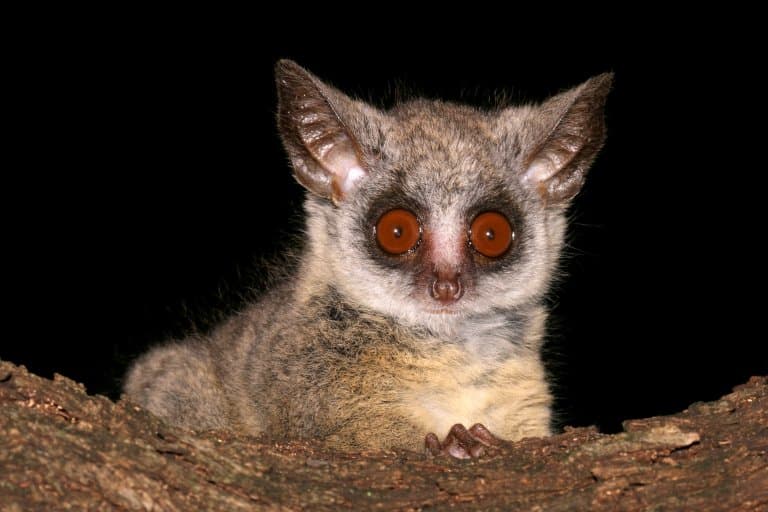
6. They live together by day, but forage alone at night
During the day, when bush babies sleep, they will often group together, generally a mother and her young of different ages. Family groups of 2-7 are common.
Males have been seen to sleep alone but have been seen with a group also. When night comes, they often split up in search for food.
7. Bush babies have human like cries
Apart from scent marking, much communication between galagos is carried out vocally. This can be to show territories, to express alarm, to gather individuals together, to show aggression or from an infant to a mother (to name but a few).
Within each species they have a vast repertoire of calls varying from squeaks, croaks and clicks to grunts and cries. One of the loud calls from the greater bush baby actually sounds like a human baby crying, and this helped give bush babies their common name.
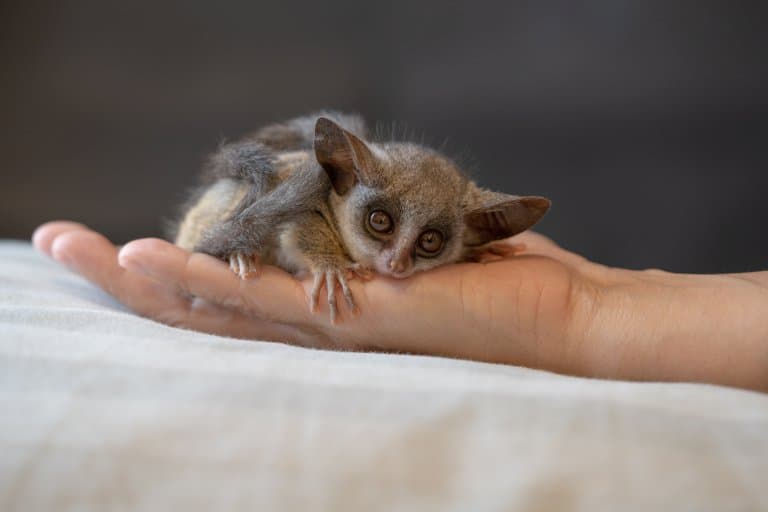
8. They can jump over 2m!
Galagos have remarkable jumping ability. They are able to cover large distances in a single hop, as well as in a series of rapid leaps.
It is thought that the muscle mass in their hind legs is large compared to the size of their bodies and this helps account for their exceptional jumping skills.
Their hind leg muscle mass makes up 25% of their total body mass.
They use this incredible trait to cover large distances in search of food, such as fruits and insects. It also comes in pretty handy when trying to escape predators.
Bush babies have a long upper part of their feet, the tarsus. This actually helps them when running but also allows them to leap long distances too. 3
9. Their tails are longer than their body and head combined
They use them expertly in their jumping technique. Their exceptionally long tails also help when balancing in the treetops. They can also hop on two feet and walk on all fours when needed.
10. They can snatch flying insects out of the air
Bush babies have incredible hand-eye coordination and speed. They have been seen to grab insects quickly out of the air with either one or both hands.
This is done in the dark and because insects move rapidly, the bush baby needs great coordination to be able to carry this out.
11. They extract and eat resin/gum from trees
Galagos will create holes in bark and scratch at them with their tooth combs to help extract the gum from the outer surface of a tree.
12. Larger bush babies can’t eat just insects alone
Smaller species of galago can survive on predominantly insects to meet their energy requirements, however insects by themselves will not sustain some of the larger species.
They have to make up the majority of their diet with fruits and gum and sometimes even small frogs and birds can be on the menu.
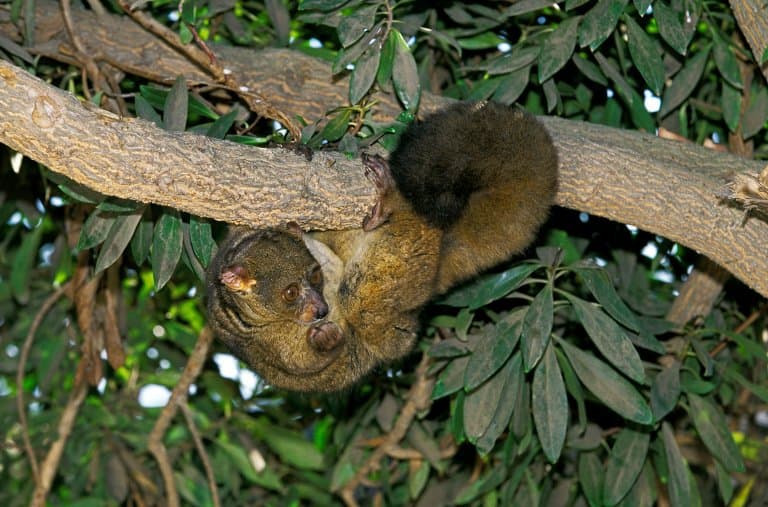
13. They like to stretch and yawn
As bush babies wake, usually at dusk, they will spend some time stretching and yawning before they get ready to search for food. Awww.
They will also take part in some grooming activities before moving around to forage.
14. Chimps hunt them with spears
Galagos have a variety of predators, and not many as as intelligent as the chimpanzee, that utilise a spear to poke into hollow trees during the day to extract the bush baby!
15. They are intimate creatures
Galagos have been observed touching noses with one another and putting their noses on each other’s faces. They also take part in other activities such as sniffing and making contact with genitals.
Galagos will also groom one another by licking and touching and this is primarily done within groups that sleep together. 4
16. Lesser bush baby newborn weight less than half an ounce
Females are excellent mothers, and will have up 1-3 babies at a time. The lesser bush baby newborn are tiny, and weigh less than half an ounce!
They will cling to their mother suckling for up to 6-8 weeks before feeding for themselves.
17. They’ve been adopted by other primates
A baboon in a Kenyan orphanage adopted a bush baby, which is similar to other instances found in East Africa where a gorilla did the same thing!
Galago Fact-File Summary
Scientific Classification
| Kingdom: | Animalia |
| Phylum: | Chordata |
| Class: | Mammalia |
| Order: | Primates |
| Family: | Galagidae |
| Genera: | Euoticus Galago Galagoides Otolemur Paragalago Sciurocheirus |
| Species Names: | Euoticus (Needle-clawed bushbabies) – Southern needle-clawed bushbaby, E. elegantulus – Northern needle-clawed bushbaby, E. pallidus Galago (Lesser galagos) – Somali bushbaby, G. gallarum – Mohol bushbaby, G. moholi – Senegal bushbaby, G. senegalensis – Dusky bushbaby, G. matschiei Galagoides (Western dwarf galagos) – Prince Demidoff’s bushbaby, Gs. demidovii – Angolan dwarf galago, Gs. kumbirensis – Thomas’s bushbaby, Gs. thomasi Otolemur (Greater galagos) – Brown greater galago, O. crassicaudatus – Northern greater galago, O. garnettii – Silvery greater galago, O. monteiri Paragalago (Eastern dwarf galagos) – Kenya coast galago, P. cocos – Grant’s bushbaby, P. granti – Malawi bushbaby, P. nyasae – Zanzibar bushbaby, P. zanzibaricus – Uluguru bushbaby, P. orinus – Rondo bushbaby, P. rondoensis – Rungwe dwarf galago, P. sp. nov. Sciurocheirus (Squirrel galagos) – Bioko Allen’s bushbaby, S. alleni – Cross River bushbaby, S. cameronensis – Gabon bushbaby, S. gabonensis – Makandé squirrel galago, S. makandensis |
Fact Sources & References
- “Lesser Bush baby“, African Wildlife Foundation.
- Anderson, M.J., Ambrose, L., Bearder, S.K. et al (2000), “Intraspecific Variation in the Vocalizations and Hand Pad Morphology of Southern Lesser Bush Babies (Galago moholi): A Comparison with G. senegalensis“, International Journal of Primatology.
- “Bush babies“, National Geographic.
- A. J Haddow, J. M Ellice (1964), “Studies on bush-babies (Galago spp.) with special reference to the epidemiology of yellow fever“, Transactions of The Royal Society of Tropical Medicine and Hygiene.
